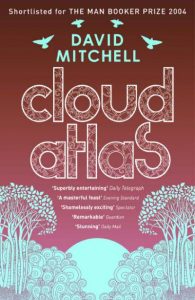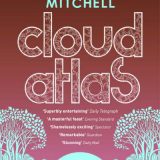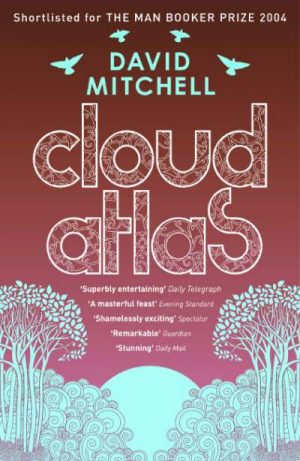Cloud Atlas – David Mitchell – 2004
Posted by Sterling on 5/1/2013, 10:30:04
To my delight, the reputedly “post-modern” Cloud Atlas is just as readable and entertaining as Jacob de Zoet. It’s something of a tour-de-force in that Mitchell writes six loosely connected stories in six different styles.
The first is set in the early 19th century in the South Pacific. It feels very much like TTAOJDZ (The Thousand Autumns of Jacob de Zoet). The second is a set of highly literate letters from a very young, bisexual composer in 1931. The third is a thriller about deadly corporate malfeasance starring a determined young woman reporter. It’s set in 1975. The fourth is a memoir of the “ghastly ordeal” of a sixty-something vanity publisher set in pretty much the present. Not unlike the young composer, his voice is witty, ironic, and urbane. The fifth is completely an interrogation set in Korea, perhaps in the mid-22nd century. The sixth is a Riddley Walker-esque exercise in post-apolcalyptic science fiction.
The other trick is that the first five stories are split in the middle. The book is structured 1,2,3,4,5,6,5,4,3,2,1. Although the stories are more-or-less complete in themselves, they are, as I said, loosely interconnected. At least one of these connections I thought so clever that I was delighted. The other most “experimental” aspect of the novel is attempting to figure out what is supposedly a “true” memoir and what is supposedly “fiction.” I won’t spoil this by saying any more about it.
In any event, it is as entertaining, easy to read, absorbing, and well written as TTAOJDZ. I almost wish that we had selected this one instead, but then we would have missed out on the joy of de Zoet. Highly recommended.
~
Posted by guillermo maynez on 19/2/2013, 16:49:10, in reply to “Cloud Atlas”
I’ve finished “Cloud Atlas” and enjoyed it a lot, I think it’s one of the best contemporary novels I’ve read. It’s original, innovative, fun, and certainly a feat of writing convincingly six different stories that mysteriously cohere and make sense in a single book.
Now, Sterling, I’m eager for the spoilers: what connecting threads did you find? Beyond the birth-mark?
~
Posted by Sterling on 21/2/2013, 23:28:17, in reply to “Re: Cloud Atlas (spoilers)”
Well, the birthmark is the most obvious connection. Why do you suppose Meronym has the birthmark instead of Zachry? In all the other stories, it is the protagonist that has the birthmark. Story 6 could have been told interestingly from Meronym’s viewpoint, but it was not. Why not?
Another connection is the number 6. Six stories, the Cloud Atlas sextet, Sixsmith, there are sixes throughout all the stories. Each story relates in some way to the theme of preying on or enslaving others. Indeed, stories 1 and 6 are directly about a war-like predatory tribe attacking, killing, and enslaving a more peaceful tribe.
What I was referring to when I said that I was “delighted” was the emergence of Somni as a Christ-like goddess figure in Zachry’s world. I certainly didn’t see that coming!
I had a great deal of fun twisting my mind around the apparently fictional Story 3, “Half-Lives: The First Luisa Rey Mystery.” You can’t really have the “first mystery” of a series be non-fiction, can you? But if Story 3 is fictional, doesn’t that make Sixsmith fictional? And if so, then is Ewing fictional? Are the only “true” stories 4, 5, and 6? Perhaps whoever “wrote” Story 3 “tarted up” a true story as a mystery novel. Story 3 takes place in a fictional setting “Buenas Yerbas.” (Isn’t that like “good marijuana?”) The other stories are all set somewhere real. Even Stories 5 (Korea) and 6 (Hawaii). Perhaps the author of Story 3 has the birthmark and placed it on Luisa. Maybe the author knew the historical Sixsmith and knows of the letters. But then why write them into a mystery? I find all this great fun to turn over in my mind. :^)
~

















